DSLRs offer an ideal entry point into astrophotography with their versatility and affordability. You’ll benefit from their APS-C CMOS sensors that enable long exposures for capturing deep-sky objects, while the Live View feature simplifies focusing on distant celestial bodies. With a basic setup under $2,000 including a Canon Rebel camera, refractor telescope, and tracking mount, you’re well-equipped to photograph everything from wide-field Milky Way shots to detailed planetary images. The complete guide below reveals essential techniques to elevate your night sky photography.
Why Start Telescope Astrophotography With Your DSLR?

Why struggle with specialized astronomical cameras when the perfect beginner’s tool might already be in your camera bag? Your DSLR offers an ideal entry point into the enchanting world of telescope astrophotography with its APS-C CMOS sensor that delivers excellent signal-to-noise ratio for longer exposures without losing detail.
You’ll appreciate the seamless shift from regular photography to capturing deep-sky images, using a camera you’re already comfortable with. By simply adding a T-adapter and T-ring (about $50), you can connect your DSLR to virtually any telescope.
Many entry-level DSLRs, like Canon’s Rebel series, can even be modified to enhance sensitivity to H-alpha wavelengths. Plus, your camera’s Live View feature makes focusing on distant celestial objects much easier than with specialized equipment.
DSLR Cameras: The Perfect Gateway to Astrophotography
DSLR cameras offer you an affordable entry into the enchanting world of astrophotography without requiring specialized equipment that costs thousands of dollars.
Your everyday DSLR becomes a versatile tool that shifts seamlessly between daytime photography and nighttime stargazing adventures.
You’ll appreciate the gentle learning curve these cameras provide, with familiar controls and settings that make mastering the fundamentals of astrophotography more accessible than you might expect.
Affordable Entry Point
Three key factors make modern DSLR cameras an exceptional starting point for aspiring astrophotographers.
First, entry-level models like the Canon Rebel series provide a budget-friendly option at around $500, considerably less expensive than dedicated astronomy cameras.
Second, you’ll benefit from versatility that justifies your investment—the same DSLR that captures Jupiter’s bands tonight can photograph landscapes tomorrow. This multi-purpose functionality delivers tremendous value as you develop your skills.
Finally, today’s DSLRs pack impressive technical capabilities for deep-sky astrophotography. Their APS-C sensors handle long exposures with minimal noise, essential for capturing faint nebulae and galaxies.
Features like Live View simplify focusing on stars, while custom modifications can enhance red sensitivity for specific celestial objects. You’re getting professional-grade potential at a fraction of specialized equipment costs.
Versatile Everyday Equipment
A single DSLR camera serves as the cornerstone of multiple photography genres, making it the ultimate versatile tool for aspiring astrophotographers.
You’ll appreciate how your Canon Rebel or similar DSLR shifts seamlessly from daytime photography to capturing celestial wonders at night.
Modern DSLR cameras feature high-quality CMOS camera sensors that handle long exposures with minimal noise—perfect for revealing faint deep-sky objects.
With a simple T-ring adapter, you can connect your camera directly to your telescope, instantly transforming it into a powerful deep-sky astrophotography system.
The versatility extends beyond hardware compatibility.
Your DSLR can capture everything from wide-field Milky Way shots to detailed planetary images, and can even be modified to enhance sensitivity to nebula emissions.
This flexibility guarantees your investment continues delivering value as your skills grow.
Easy Learning Curve
The gentle learning slope of astrophotography begins with equipment you likely already understand. Canon EOS Rebel and similar DSLR cameras offer an intuitive entry point that minimizes the technical hurdles you’ll face. Their ease of use allows you to focus on composition and technique rather than complex equipment operation.
Live View functionality transforms the challenging task of focusing on distant stars into a straightforward process, letting you see results in real-time. Modern DSLRs with their low-noise CMOS sensors rival mid-range astronomical cameras, allowing for longer exposures with impressive detail retention.
As your skills advance, simple modifications can enhance your DSLR’s red sensitivity for capturing hydrogen emissions in deep-sky imaging.
Best of all, integrating with telescope systems requires minimal additional astrophotography gear, keeping your learning journey accessible and affordable.
Budget-Friendly Equipment Options for Beginners
Starting your telescope astrophotography journey doesn’t require emptying your bank account. You can assemble a capable setup for under $2,000 that delivers impressive results on deep-sky targets. The Canon EOS Rebel T7 DSLR camera ($500) offers excellent versatility while remaining budget-friendly for beginners.
| Equipment | Purpose | Cost |
|---|---|---|
| Canon EOS Rebel T7 | Primary imaging device | $500 |
| RedCat 51 Refractor | Sharp, maintenance-free optics | $850 |
| Star Adventurer Tracking Mount | Prevents star trails | $300 |
| T-adapter & T-ring | Camera-telescope connection | $50 |
| Carbon Fiber Tripod | Stable platform | $100-300 |
Pair your DSLR with a compact refractor like the William Optics RedCat 51 for crisp images without collimation hassles. Add a Star Adventurer tracking mount for longer exposures that reveal faint celestial details.
Essential Adapters for Connecting Your DSLR to a Telescope

Connection challenges often frustrate beginners attempting their first telescope-camera integration. The solution is simpler than you might think: you’ll need just two essential components—a T-adapter and a camera-specific T-ring.
The T-adapter fits directly into your telescope’s focuser, while the T-ring attaches to your DSLR body (like Canon’s EF-mount). Together, they create a secure, properly aligned connection that minimizes movement during long exposures.
When shopping for these adapters, verify compatibility with your telescope’s focuser diameter. Different telescopes require specific adapter sizes to function correctly.
The good news? This critical astrophotography hardware won’t break the bank. For approximately $50, you’ll have everything needed to transform your telescope and DSLR into a powerful deep-sky imaging system.
Choosing the Right Entry-Level Refractor Telescope
When first venturing into astrophotography, selecting an appropriate telescope becomes your most critical decision. A 102mm apochromatic refractor telescope offers an ideal starting point, combining portability with optical quality tailored for DSLR astrophotography.
You’ll appreciate that refractors deliver sharp images with a flat field—essential qualities for capturing detailed celestial photographs. Unlike other types, these telescopes don’t require collimation, eliminating a common frustration for beginners and simplifying your setup process.
Many entry-level refractor telescopes come equipped with adjustable focusers and camera mount compatibility, making them perfectly suited for your DSLR.
With prices starting around $500, they strike an excellent balance between affordability and performance. This investment provides the optical quality you need without overwhelming your budget as you develop your astrophotography skills.
Mount Considerations for Stable Imaging

Your mount choice will make or break your astrophotography efforts, as even the finest telescope and camera setup can’t overcome poor tracking and stability issues.
While German Equatorial Mounts offer precise celestial tracking essential for deep-sky imaging, beginners might start with portable star trackers that support lighter DSLR and lens combinations.
You’ll need to carefully match your mount’s payload capacity to your equipment weight, ideally using only 60-70% of the maximum capacity to maintain peak tracking accuracy during long exposures.
German Equatorial Mount Benefits
Although budget options exist for beginners, a German equatorial mount (GEM) represents one of the most significant investments you’ll make in your astrophotography journey. When capturing deep-sky objects, tracking accuracy becomes essential for successful long exposure images without star trails.
| Feature | Benefit |
|---|---|
| Precise polar alignment | Compensates for Earth’s rotation accurately |
| Autoguiding capability | Refines tracking during extended exposures |
| Versatility | Accommodates different telescope configurations |
| Stability | Minimizes vibrations that cause image blur |
| Long-term value | Grows with your astrophotography skills |
A quality GEM delivers exceptional performance that directly translates to sharper, more detailed astrophotography images. While the initial cost may seem steep, you’ll quickly appreciate the mount’s ability to track celestial objects with remarkable precision, allowing you to capture stunning nebulae, galaxies, and star clusters.
Star Trackers Versus Mounts
Many beginning astrophotographers face an essential decision between star trackers and full equatorial mounts, each offering distinct advantages for different imaging scenarios.
Star trackers provide an affordable entry point (starting around $200) for lightweight DSLR setups, allowing long exposures without star trails. They’re perfect if you’re using smaller lenses or telescopes and have portability concerns.
German Equatorial Mounts deliver superior stability and tracking accuracy for serious astrophotography. While more expensive (starting at $300), GEMs handle heavier equipment and offer autoguiding capabilities that continuously correct tracking errors.
This precision becomes vital when capturing deep-sky objects that require extended exposures.
Your choice ultimately depends on your equipment weight and imaging goals. Remember that a stable mount is non-negotiable—even minor vibrations will transform potential masterpieces into blurry disappointments.
Mount Payload Capacity
Three critical factors determine successful astrophotography, with payload capacity ranking near the top of this essential list. Your equatorial telescope mount must support not just the weight of your equipment but provide enough overhead for stability during long exposures.
When selecting a mount for your DSLR cameras and telescope, always calculate the total weight of your imaging equipment, then choose a mount with at least 1.5 times that capacity. This buffer prevents vibrations that can ruin your shots.
| Mount Type | Ideal Payload Ratio | Benefits |
|---|---|---|
| GEM | 1.5x equipment weight | Superior tracking accuracy |
| Alt-Az | 2x equipment weight | Less stable for imaging |
| Portable | 3x equipment weight | Needs extra capacity for stability |
Remember: underestimating your mount payload capacity creates frustrations that even the best telescope can’t overcome.
Camera Settings for Capturing Deep-Sky Objects

Successful deep-sky astrophotography relies on five essential camera settings that maximize your DSLR’s ability to collect faint light.
First, switch to manual mode and select a high ISO setting between 800-3200 to capture distant celestial objects. While higher values increase sensitivity, they also affect your signal-to-noise ratio, so finding the right balance is vital.
Manual mode with ISO 800-3200 balances light sensitivity and noise when photographing the night sky’s faintest objects.
Open your camera lens to its widest aperture (lowest f-stop) to gather maximum light. For exposures, start with 15-30 seconds depending on your focal length, extending to minutes via Bulb mode with a remote trigger for deep sky astrophotography targets. This prevents camera shake during long exposures.
Finally, plan to capture multiple frames of the same subject for later stacking, which dramatically improves image quality by reducing noise while preserving subtle details.
Recommended Accessories Under $100
Getting started with telescope astrophotography doesn’t require emptying your wallet. A few affordable accessories can greatly improve your imaging results while keeping costs down.
| Accessory | Price Range | Primary Benefit |
|---|---|---|
| T-Ring adapter | $30-50 | Connects DSLR to telescope for proper alignment |
| T-Adapter | $30-50 | Secures camera to focuser for ideal imaging |
| Light pollution filters | Under $100 | Blocks unwanted urban light for clearer images |
Don’t overlook the importance of a sturdy tripod ($50-100), which provides essential stability, especially when using longer exposures. For more advanced imaging sessions, consider adding a small guide scope (under $100) to improve tracking accuracy and enhance your final images. These affordable additions will greatly boost your astrophotography capabilities without breaking the bank.
Tracking the Night Sky: Basic Techniques

Capturing the cosmos requires mastering fundamental tracking techniques to overcome Earth’s constant rotation. Without proper tracking, your long exposures will show star trails instead of pinpoint stars. A star tracker or German equatorial mount compensates for Earth’s movement, allowing your DSLR to capture detailed celestial objects.
Before you begin tracking the night sky, focus on these essentials:
- Proper polar alignment – Align your mount with Polaris (in the Northern Hemisphere) for accurate tracking.
- Exposure calculation – Apply the Rule of 400 (divide 400 by your lens focal length) to determine maximum exposure time.
- Focus optimization – Use your DSLR’s Live View mode to achieve precise focus on stars.
Set your camera to manual mode with high ISO (around 1600) and the widest aperture for initial shots while you perfect your tracking technique.
Common Challenges and Simple Solutions
Despite your best efforts, telescope astrophotography will present obstacles that might initially seem frustrating. Achieving focus through your telescope’s focal length is often challenging, but your DSLR camera’s Live View feature allows you to zoom in on stars for precise adjustments.
Battery management deserves serious attention—always carry an extra charged battery, as features like Live View drain power quickly during long imaging sessions.
When connecting your DSLR camera to your telescope, invest approximately $50 in compatible T-Adapters and T-Rings to guarantee proper attachment.
Light pollution can wash out deep-sky objects, but simple post-processing techniques can help recover details. Even basic image stacking software can dramatically improve your results without requiring advanced skills.
Remember that mastering exposure settings, particularly using the rule of 400 to prevent star trails, will immediately enhance your images.
Processing Your First Deep-Sky Images
Processing your first deep-sky images requires mastering key techniques like stacking and calibration to transform raw captures into stunning celestial portraits.
You’ll need to select appropriate software tools—such as DeepSkyStacker for beginners or PixInsight for advanced users—that match your skill level and processing goals.
Effective noise reduction strategies, including dark frame subtraction and careful adjustment of brightness and contrast, will dramatically improve your final image quality while preserving critical details.
Core Processing Techniques
Once you’ve collected your raw deep-sky images, the real magic begins with proper processing techniques. To transform your raw captures into stunning celestial portraits, you’ll need to enhance the signal-to-noise ratio through careful post-processing.
Start by utilizing dark frames to calibrate your images and eliminate unwanted noise patterns and hot pixels.
The cornerstone of deep-sky astrophotography lies in these essential steps:
- Stack your images using specialized software like DeepSkyStacker, which combines multiple exposures to reveal faint details invisible in single frames.
- Apply initial adjustments to brightness, contrast, and color balance to bring out celestial features.
- Refine your image with targeted sharpening and noise reduction techniques while preserving delicate details.
Save your masterpiece in high-quality format like TIFF to preserve all your hard work.
Software Selection Guide
Choosing the right software makes all the difference when transforming your raw deep-sky captures into breathtaking celestial portraits. For your first deep-sky images, specialized tools like DeepSkyStacker outperform general photo editors by efficiently stacking multiple exposures to reduce noise and reveal faint details.
While free software options exist, they often produce inferior results with longer processing times. Consider investing in quality processing tools like Astro Pixel Processor (APP), which offers advanced features specifically designed for handling astrophotography’s unique challenges.
Always work with RAW files rather than JPEGs to retain maximum data for post-processing adjustments.
Remember to perform proper calibration steps, including dark-frame subtraction at identical temperature and exposure settings. Your final images will require careful brightness, contrast, and color balance adjustments to truly showcase the celestial wonders you’ve captured.
Noise Reduction Strategies
Three critical challenges await every astrophotographer when processing deep-sky images, with noise being the most persistent adversary.
You’ll need to implement effective noise reduction techniques to reveal the cosmos hiding behind digital grain. Dark-frame calibration provides your foundation—capture images with the lens covered using identical exposure settings to identify and subtract noise patterns from your light frames.
- Improve your signal-to-noise ratio by stacking multiple exposures, which averages out random noise while enhancing faint details.
- Utilize specialized software like DeepSkyStacker or Astro Pixel Processor that automatically aligns, stacks, and reduces noise.
- Apply post-processing techniques such as Gaussian blur or median filtering with restraint—finding the perfect balance preserves detail without creating unwanted artifacts.
Don’t overprocess; the difference between professional and amateur results often lies in this delicate balance.
Frequently Asked Questions
Can You Do Astrophotography With Just a DSLR?
Yes, you can absolutely do astrophotography with just a DSLR. You’ll capture impressive night sky images using your camera on a tripod with long exposures and the right settings.
What Is the 400 Rule in Astrophotography?
The 400 Rule helps you calculate maximum exposure time to avoid star trails. Simply divide 400 by your lens’s focal length in mm. For a 50mm lens, you’d use an 8-second exposure maximum.
Why DSLR for Astrophotography?
You’ll find DSLRs ideal for astrophotography because they’re versatile, affordable, and user-friendly. They offer excellent low-light performance, modified red sensitivity for nebulae, and convenient Live View focusing for crisp celestial images.
What Is the Best Starter Camera for Astrophotography?
For beginner astrophotographers, you’ll find the Canon EOS Rebel series (like 450D or 600D) is your best starter option. They’re affordable, user-friendly, and offer great APS-C sensors that handle long exposures with minimal noise.
In Summary
You’re now equipped to begin your astrophotography journey with your DSLR. Don’t worry about perfection—embrace the learning process. Start with simple targets, experiment with exposure settings, and gradually add accessories as you develop your skills. The universe awaits your unique perspective, and you’ll soon find yourself capturing celestial wonders you never thought possible. Clear skies and happy shooting!
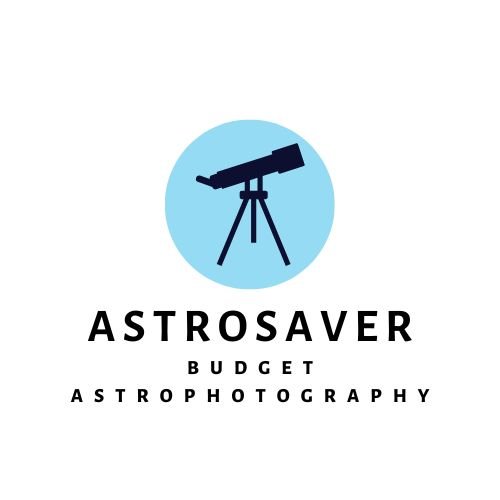
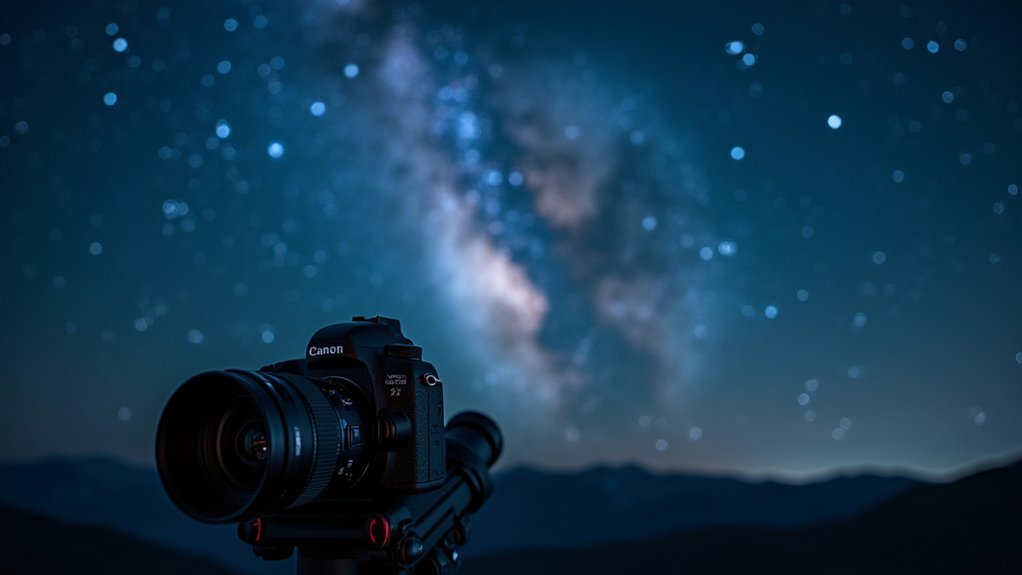
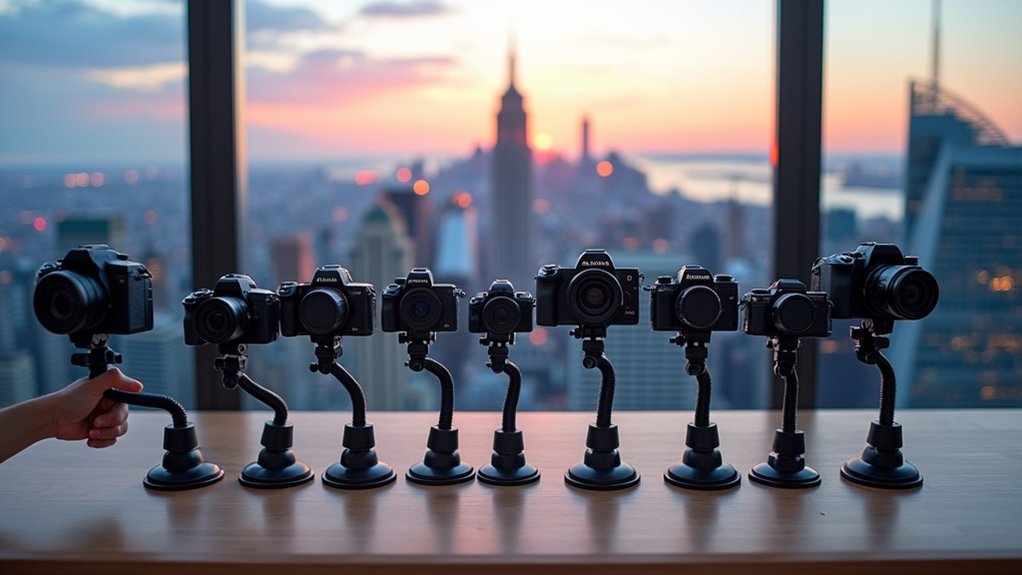
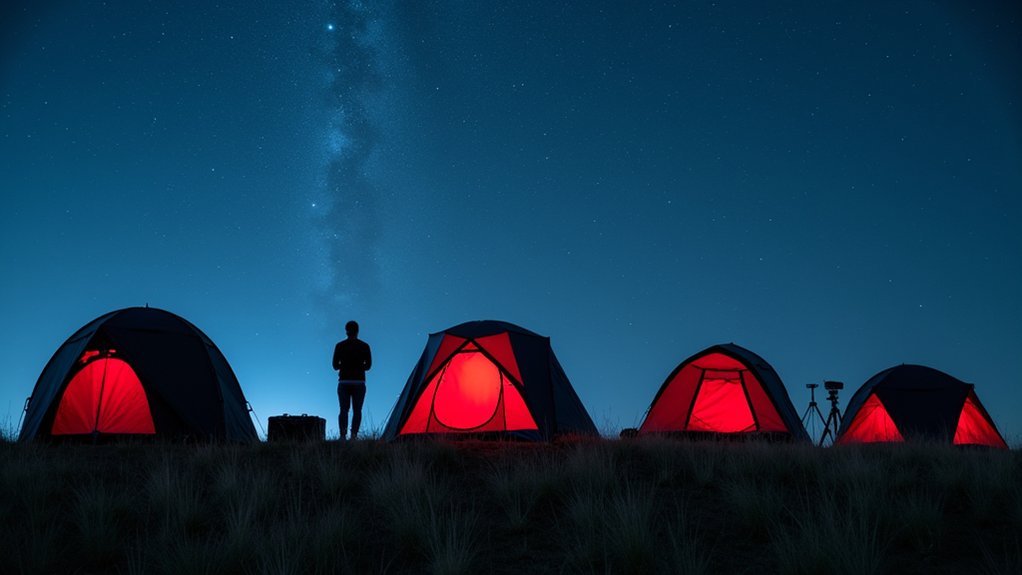
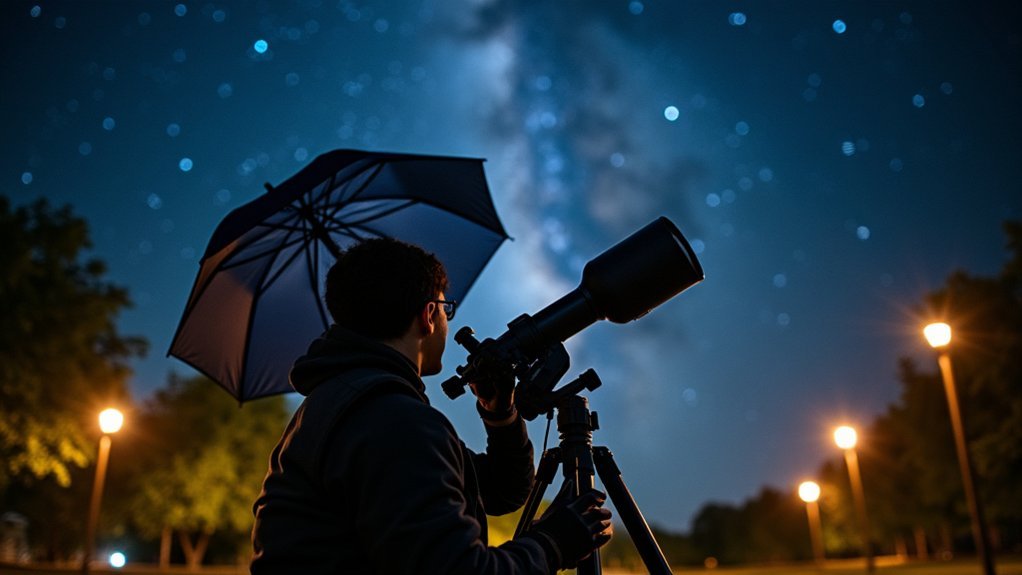
Leave a Reply